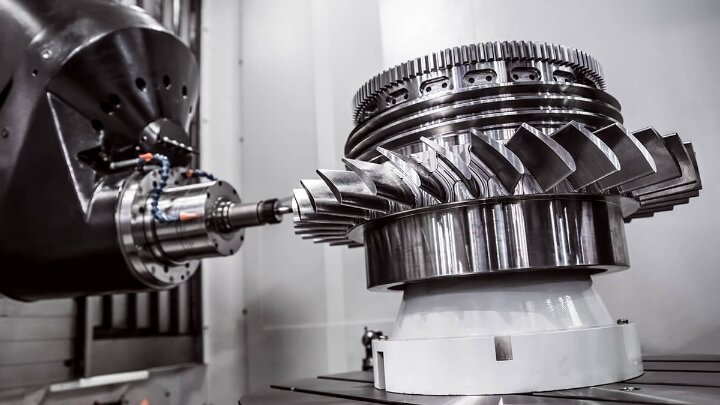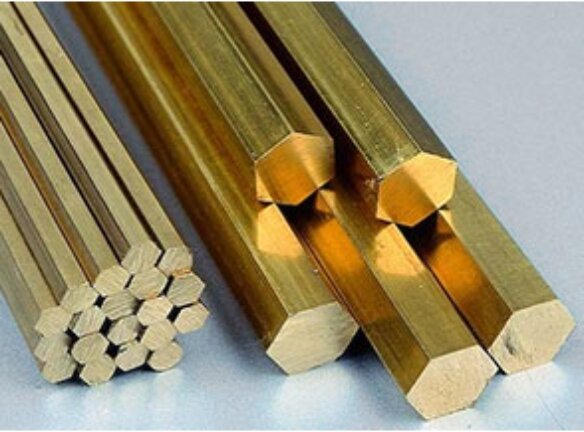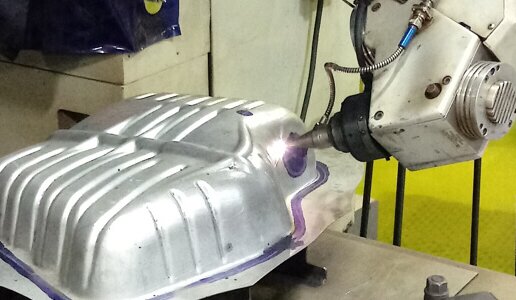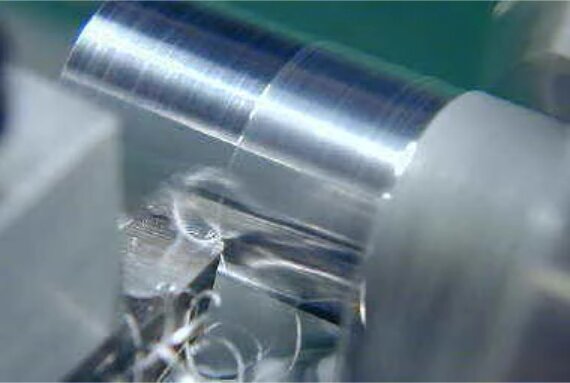Los ingenieros y diseñadores se esfuerzan a menudo por seleccionar un proceso de conformado de metales adecuado que equilibre precisión, durabilidad y viabilidad económica. El estampado de cobre se perfila como una solución revolucionaria que permite a los fabricantes transformar materias primas en componentes complejos de alto rendimiento con notable eficacia.
Este blog pretende aclarar los entresijos de la estampación de cobre y hacerla accesible a ingenieros, diseñadores y fabricantes por igual.
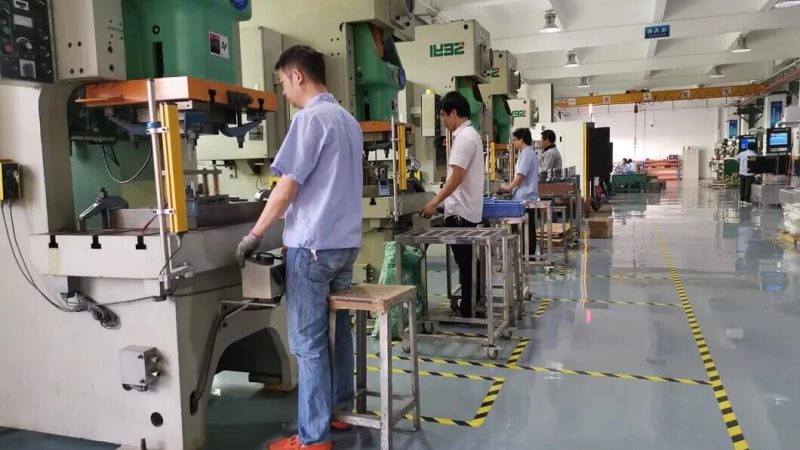
Fundamentos de la estampación en cobre
El estampado de cobre es un proceso de fabricación que consiste en moldear láminas de cobre con formas específicas utilizando una prensa de estampación equipada con matrices. Comprender los fundamentos de la estampación de cobre puede mejorar significativamente su capacidad para diseñar y fabricar componentes prácticos.
¿Qué es la estampación en cobre?
El estampado de cobre es una técnica de fabricación que transforma láminas planas de cobre en formas y diseños intrincados. El proceso suele realizarse con una prensa de estampación equipada con una matriz que aplica una fuerza considerable para dar forma al metal. Este método se utiliza ampliamente en varias industrias debido a la excelente conductividad, flexibilidad y resistencia a la corrosión del cobre.
Propiedades del cobre relevantes para la estampación
El cobre posee varias propiedades fundamentales que lo hacen especialmente adecuado para aplicaciones de estampación:
- Excelente conductividad eléctrica y térmica: El cobre es famoso por su conductividad superior, crucial para los componentes eléctricos.
- Maleabilidad: El cobre puede moldearse fácilmente sin romperse, lo que permite a los fabricantes crear diseños intrincados.
- Resistencia a la corrosión: El cobre desarrolla de forma natural una capa protectora de óxido que mejora su resistencia a la corrosión.
- Ductilidad: La capacidad del cobre para sufrir deformaciones importantes sin fracturarse le permite soportar las tensiones del proceso de estampación.
Cómo elegir el material de cobre adecuado para su proyecto
Seleccionar el material de cobre adecuado para su proyecto de estampación implica tener en cuenta varios factores:
- Requisitos de solicitud: Evalúe si su proyecto prioriza la conductividad eléctrica, la solidez o la resistencia a la corrosión.
- Condiciones ambientales: Tenga en cuenta el entorno de funcionamiento. Si los componentes van a estar expuestos a la humedad o a productos químicos, puede resultar ventajoso utilizar una aleación resistente a la corrosión.
- Procesos de manufactura: Evalúe cómo se comportará el material elegido durante el estampado y los procesos posteriores, como la soldadura o el soldadura.
Técnicas de estampación en cobre
La estampación del cobre abarca diversas técnicas adaptadas a las necesidades específicas de producción y a los requisitos de diseño. A continuación, exploramos cuatro técnicas principales de estampación utilizadas en la fabricación de cobre.
Estampación progresiva
Estampación con troqueles progresivos es un método muy eficaz que utiliza una serie de matrices para realizar múltiples operaciones en una tira continua de cobre. A medida que la tira de metal se desplaza por la máquina, cada estación de troquelado realiza una tarea específica -cortar, doblar o dar forma- hasta completar la pieza final.
Estampado profundo
Estampación profunda es una técnica para crear formas profundas y huecas a partir de láminas planas de cobre. Este proceso consiste en embutir el metal en una cavidad mediante un punzón, que estira el material y le da la forma deseada.
Acuñación y estampación
El acuñado y el gofrado son técnicas de estampado que crean diseños en relieve o rebajados en superficies de cobre. El acuñado implica aplicar alta presión para formar formas o patrones precisos, mientras que el gofrado crea diseños en relieve empujando material desde detrás de la lámina.
Corte fino de piezas de precisión
Blanqueo fino es un proceso de estampación especializado que produce piezas con tolerancias extremadamente estrechas y bordes lisos. Esta técnica consiste en utilizar una prensa de corte que aplica una fuerza considerable para cortar el metal limpiamente sin deformarlo.
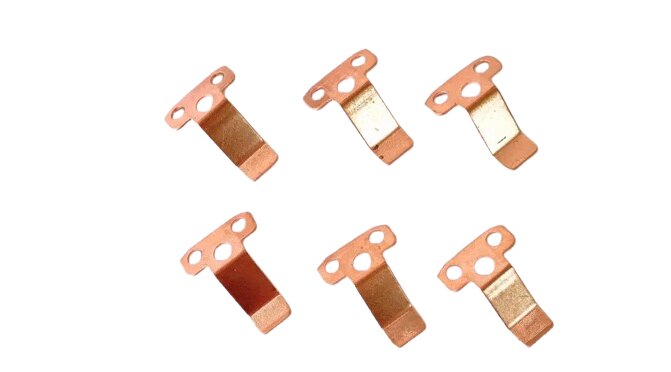
Cómo estampar cobre: Guía paso a paso
La estampación del cobre transforma las materias primas en componentes de precisión mediante etapas de fabricación meticulosamente planificadas. Cada etapa requiere conocimientos técnicos, equipos avanzados y una cuidadosa atención al detalle.
Selección y preparación del material
Los técnicos inspeccionan cuidadosamente el grosor del material, la calidad de la superficie y las propiedades metalúrgicas. Limpian y aplanan las láminas de cobre, eliminando los contaminantes superficiales que podrían comprometer la precisión del estampado.
Etapas del proceso de estampación
La operación de estampación consta de varias fases críticas. Las prensas mecánicas aplican una fuerza controlada para deformar las láminas de cobre utilizando matrices diseñadas con precisión. Los componentes complejos suelen requerir varios ciclos de estampación, con recocido intermedio para mantener la ductilidad del material y evitar el endurecimiento por deformación.
Control de calidad e inspección
Las rigurosas medidas de control de calidad garantizan que cada componente estampado cumpla las especificaciones exactas. Los técnicos utilizan equipos de medición avanzados, como máquinas de medición por coordenadas (MMC), para verificar la precisión dimensional.
Utillaje para estampación de cobre
El utillaje es un aspecto crítico del proceso de estampación de cobre, ya que afecta directamente a la calidad y eficacia de la producción. Esta sección cubre las consideraciones de diseño para las matrices de estampación de cobre y los materiales utilizados habitualmente en las herramientas de estampación.
Consideraciones sobre el diseño de matrices de estampación de cobre
Al diseñar matrices para la estampación de cobre, deben tenerse en cuenta varios factores clave para optimizar el rendimiento y la longevidad:
- Geometría del troquel: La forma y la configuración de la matriz deben coincidir con el diseño previsto de la pieza estampada.
- Liquidación: Una holgura adecuada entre la matriz y el punzón es crucial para evitar una fricción excesiva, que puede provocar desgaste o daños.
- Selección de materiales: Los materiales de las matrices deben soportar altas presiones y resistir el desgaste, manteniendo la precisión dimensional durante toda su vida útil.
- Facilidad de mantenimiento: Diseñar las matrices teniendo en cuenta el mantenimiento puede facilitar reparaciones o ajustes más rápidos.
Materiales utilizados en las herramientas de estampación
La selección de materiales para las herramientas de estampación es crucial para conseguir las características de rendimiento deseadas. Los materiales más comunes utilizados en la construcción de matrices de estampación incluyen:
- Herramienta de acero: Los aceros para herramientas de alto contenido en carbono y aleados se utilizan con frecuencia debido a su excelente dureza, resistencia al desgaste y capacidad para conservar los bordes afilados.
- Carburo cementado: Conocido por su excepcional dureza y resistencia al desgaste, suele utilizarse en aplicaciones de alto rendimiento en las que la durabilidad es primordial.
- Carburo cementado con liga de acero: Este material combina la tenacidad del acero con la dureza del carburo cementado, lo que lo hace adecuado para aplicaciones que requieren fuerza y resistencia al desgaste.
- Bronce Aluminio: Para aplicaciones en las que intervienen metales no ferrosos como el cobre, el bronce de aluminio puede utilizarse como material para matrices debido a sus buenas propiedades antiadherentes.
- Materiales poliméricos: En algunos casos, se utilizan materiales a base de polímeros para aplicaciones específicas en las que se acepta una menor resistencia al desgaste pero se desea ahorrar peso.
Estampación en cobre: Ventajas e inconvenientes
El estampado de cobre es un proceso de fabricación muy utilizado que ofrece numerosas ventajas, pero también tiene ciertos inconvenientes. Comprender estos pros y contras puede ayudar a los fabricantes a decidir si el estampado de cobre se adapta a sus proyectos.
Pros
- Excelente conductividad eléctrica: El cobre es famoso por su conductividad eléctrica superior, lo que lo convierte en la opción ideal para aplicaciones en electrónica, automoción y sistemas eléctricos.
- Resistencia a la corrosión: La capacidad natural del cobre para resistir la corrosión prolonga la vida útil de las piezas estampadas.
- Maleabilidad y Ductilidad: El cobre se puede moldear fácilmente en intrincados diseños sin romperse.
- Atractivo estético: El tono cálido y el brillo natural del cobre añaden un valor estético distintivo a los productos.
Contras
- Elevados costes iniciales de utillaje: La producción de matrices y utillaje a medida para la estampación de cobre puede resultar cara.
- Idoneidad limitada para lotes pequeños: Los costes asociados al utillaje pueden ser superiores a las ventajas en el caso de lotes pequeños o producción de una sola pieza.
- Limitaciones de precisión: Aunque la estampación en cobre permite diseños intrincados, conseguir tolerancias muy ajustadas puede ser todo un reto.
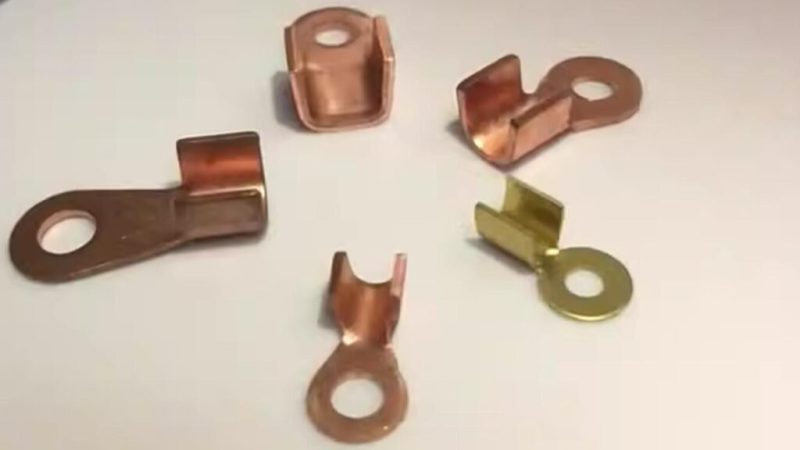
Aplicaciones del estampado de cobre
La estampación de cobre es un proceso de fabricación versátil que se utiliza en una amplia gama de industrias. A continuación, analizamos las aplicaciones fundamentales de la estampación de cobre en diversos ámbitos.
Industria Electrónica y Eléctrica
En la industria electrónica y eléctrica, el estampado de cobre es fundamental para producir componentes que requieren una alta conductividad eléctrica y fiabilidad. Entre las aplicaciones más comunes se incluyen:
- Conectores y terminales
- Disipadores de calor
- Interruptores y relés
- Circuitos impresos
Aplicaciones aeroespaciales y de automoción
El estampado de cobre también forma parte integral de las industrias automovilística y aeroespacial, donde se utiliza para fabricar componentes que deben soportar condiciones exigentes. Entre las principales aplicaciones figuran:
- Sistemas eléctricos
- Conectores y cableado
- Intercambiadores de calor
- Componentes aeroespaciales
Bienes industriales y de consumo
El estampado de cobre se utiliza ampliamente en la producción de componentes industriales y bienes de consumo. Entre sus aplicaciones destacan:
- Fontanería
- Características arquitectónicas
- Dispositivos médicos
- Electrónica de consumo
Conclusión
La estampación de cobre representa la cúspide de la tecnología de fabricación moderna, ya que aúna un diseño innovador con una ejecución de ingeniería precisa. Este sofisticado proceso transforma las materias primas de cobre en componentes de alto rendimiento, impulsando el avance tecnológico en múltiples industrias.
Hola, soy Kevin Lee

Durante los últimos 10 años, he estado inmerso en diversas formas de fabricación de chapa metálica, compartiendo aquí ideas interesantes de mis experiencias en diversos talleres.
Póngase en contacto

Kevin Lee
Tengo más de diez años de experiencia profesional en la fabricación de chapas metálicas, especializada en corte por láser, plegado, soldadura y técnicas de tratamiento de superficies. Como Director Técnico de Shengen, me comprometo a resolver complejos retos de fabricación y a impulsar la innovación y la calidad en cada proyecto.

